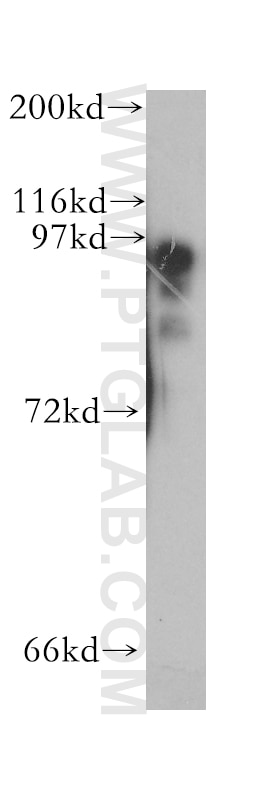- Featured Product
- KD/KO Validated
PKD2L1 Polyklonaler Antikörper
PKD2L1 Polyklonal Antikörper für WB, ELISA
Wirt / Isotyp
Kaninchen / IgG
Getestete Reaktivität
human, Maus, Ratte
Anwendung
WB, IF, ELISA
Konjugation
Unkonjugiert
Kat-Nr. : 13117-2-AP
Synonyme
Galerie der Validierungsdaten
Geprüfte Anwendungen
| Erfolgreiche Detektion in WB | humanes Lebergewebe |
Empfohlene Verdünnung
| Anwendung | Verdünnung |
|---|---|
| Western Blot (WB) | WB : 1:500-1:1000 |
| It is recommended that this reagent should be titrated in each testing system to obtain optimal results. | |
| Sample-dependent, check data in validation data gallery | |
Veröffentlichte Anwendungen
| WB | See 1 publications below |
| IF | See 2 publications below |
Produktinformation
13117-2-AP bindet in WB, IF, ELISA PKD2L1 und zeigt Reaktivität mit human, Maus, Ratten
| Getestete Reaktivität | human, Maus, Ratte |
| In Publikationen genannte Reaktivität | Maus |
| Wirt / Isotyp | Kaninchen / IgG |
| Klonalität | Polyklonal |
| Typ | Antikörper |
| Immunogen | PKD2L1 fusion protein Ag3807 |
| Vollständiger Name | polycystic kidney disease 2-like 1 |
| Berechnetes Molekulargewicht | 805 aa, 92 kDa |
| Beobachtetes Molekulargewicht | 75-85 kDa, 92 kDa |
| GenBank-Zugangsnummer | BC025665 |
| Gene symbol | PKD2L1 |
| Gene ID (NCBI) | 9033 |
| Konjugation | Unkonjugiert |
| Form | Liquid |
| Reinigungsmethode | Antigen-Affinitätsreinigung |
| Lagerungspuffer | PBS mit 0.02% Natriumazid und 50% Glycerin pH 7.3. |
| Lagerungsbedingungen | Bei -20°C lagern. Nach dem Versand ein Jahr lang stabil Aliquotieren ist bei -20oC Lagerung nicht notwendig. 20ul Größen enthalten 0,1% BSA. |
Protokolle
| Produktspezifische Protokolle | |
|---|---|
| WB protocol for PKD2L1 antibody 13117-2-AP | Protokoll herunterladen |
| Standard-Protokolle | |
|---|---|
| Klicken Sie hier, um unsere Standardprotokolle anzuzeigen |
Publikationen
| Species | Application | Title |
|---|---|---|
Front Cell Neurosci The neural stem cell properties of Pkd2l1+ cerebrospinal fluid-contacting neurons in vivo | ||
iScience Graded spikes differentially signal neurotransmitter input in cerebrospinal fluid contacting neurons of the mouse spinal cord |



